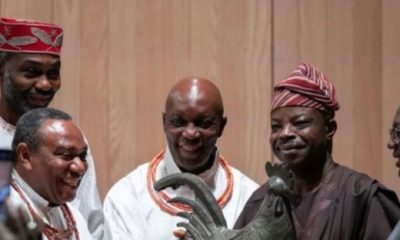News
University of Aberdeen Will Be Returning a Benin Bronze to Nigeria | Here’s What We Know

As Nigerians discover more of their history and culture, the need for sculptures and artefact that were auctioned by Britain to Western museums and collectors to be returned to the country has now become more pressing. While some museums and collectors have previously made mention of their intentions to return items in their possession, others are still in the works.
On Thursday, the University of Aberdeen made known its intentions to return a Benin Bronze to Nigeria within weeks.
Aljazeera reports that The Kingdom of Benin reached out to authorities in 2019 to arrange the return of the sculpture of an Oba of the Kingdom.
“One of the most notorious examples of the pillaging of cultural treasures associated with 19th-century European colonial expansion,” said the university whose vice-chancellor George Boyne added that “it would not have been right to have retained an item of such great cultural importance that was acquired in such reprehensible circumstances”.
The University of Aberdeen’s Museums and Special Collections also took to its Twitter page to share more information about the soon-to-be returned artefact.
Following on from this morning’s announcement of the decision to return a ‘Benin Bronze’ from the University’s collection to Nigeria, we would like to share more of the artwork’s history and reasons for its return.
Between the 13th and 19th centuries, Benin City was the principal city of the Kingdom of Benin and of the Edo people, renowned for its artistic traditions of bronze-casting and carved ivory.
Expansion of British colonial control in the late 19thC brought it into conflict with the Kingdom of Benin. In 1897 British forces attacked and destroyed Benin City killing many of its inhabitants. The royal palace was burned and looted,and the Oba, Ovonramwen Nogbaisi, exiled.
The British stole thousands of religious and cultural treasures, including the sculpture that is now in the University of Aberdeen’s collection. Many of the soldiers and administrators involved sold the objects to museums or private collectors.
Others were later given as gifts to museums or sold at auction. This Head of an Oba sculpture was purchased at auction by a University curator in 1957.
Knowing this history, to retain the artwork for our collection today would be to perpetuate the colonial violence that brought it to Britain in the first place.
1/ Following on from this morning’s announcement of the decision to return a ‘Benin Bronze’ from the University’s collection to Nigeria, we would like to share more of the artwork’s history and reasons for its return. pic.twitter.com/jVhQ6qaBjZ
— Aberdeen Uni Museums and Special Collections (@uoacollections) March 25, 2021
3/ Expansion of British colonial control in the late 19thC brought it into conflict with the Kingdom of Benin. In 1897 British forces attacked and destroyed Benin City killing many of its inhabitants. The royal palace was burned and looted,and the Oba, Ovonramwen Nogbaisi, exiled pic.twitter.com/DAnFlJvrP3
— Aberdeen Uni Museums and Special Collections (@uoacollections) March 25, 2021
6/ Knowing this history, to retain the artwork for our collection today would be to perpetuate the colonial violence that brought it to Britain in the first place.
— Aberdeen Uni Museums and Special Collections (@uoacollections) March 25, 2021
Reacting to the news, Lai Mohammed, Minister of Information and Culture said it is a “step in the right direction”, requesting others in possession of Nigerian artefact to follow suit.
“It’s part of our identity, part of our heritage… which has been taken away from us for many years,” said Professor Abba Isa Tijani, director-general of Nigeria’s National Commission for Museums and Monuments, who also declared that two more Bronzes are set to be returned by the US museums.
According to Aljazeera, newspaper reports says Germany is also working towards returning 440 Benin Bronzes soon, and the University of Cambridge’s Jesus College to return one Bronze. The British Museum has also formed a Benin Dialogue Group to discuss displaying more of these sculptures in Benin City.
Photo Credit: Aberdeen Uni Museums and Special Collections



















